San Diego’s Rady Shell adds a sensational SoCal spot for an outdoor concert

- Share via
Greetings from Los Angeles, where I’m not sure whether or not we have a local government — but we do have the arts. I’m Los Angeles Times art and design columnist Carolina A. Miranda, with the week’s essential arts and scandal news:
A lovely new venue
Earlier this month I hightailed it down to San Diego for the San Diego Symphony’s launch of their new season at the Rady Shell at Jacobs Park, the city’s new outdoor performance venue, located on a pier park near the convention center. On the docket was musical director Rafael Payare leading a performance of Verdi’s “Messa da Requiem,” a composition that began like a series of ethereal whispers and soon evolved into blazing rapture, courtesy of the San Diego Master Chorale — and some stunning performances from soprano Leah Crocetto, mezzo-soprano Jennifer Johnson Cano, tenor Limmie Pulliam and baritone Aleksey Bogdanov.
Music critic Christian Hertzog, who writes for the San Diego Union-Tribune, described it as the sort of performance in which “the world dissolved to ashes and celestial trumpets summoned the dead from their graves.”
I do appreciate any musical organization that opens a post-pandemic season with a death Mass. It felt cathartic. But I will leave the music to the experts. I was there for the architecture — though I will report that I got goose bumps during the thunderous Dies Irae.

So how did the venue acquit itself? Very handsomely.
The shell, designed by San Diego’s Tucker Sadler Architects, in collaboration with Soundforms Design Partners in London, consists of a prehensile canopy over a band shell — one that looks, quite literally, like a shell — occupying a 3.7-acre park on a jetty that extends into the San Diego Bay. Visible from the gently sloped viewing lawn are the high-rises of downtown San Diego as well as the Coronado Bridge. It is a dramatic setting — especially once the music gets going, the sun starts to set, and the golden clouds on the horizon frame the cloud-shaped forms of the Rady Shell, illuminated from within by golden light.
For classical music concerts, the place does its best to channel a Hollywood Bowl vibe: with dining tables available up front and a bevy of food options that includes snack fare as well as a pre-plated dinner with wine.
Make the most of L.A.
Get our guide to events and happenings in the SoCal arts scene. In your inbox every Monday and Friday morning.
You may occasionally receive promotional content from the Los Angeles Times.
Unlike the Hollywood Bowl, however, which protects its audience with the surrounding hills, the Rady Shell sits exposed on the water. Which means the light can be fierce. I was there on a windless 70-plus-degree day and found myself holding up my program to shield my face, as I watched the red-headed guy at the next table metamorphose into a lobster. By all means, pack sunglasses and a hat. Also, it’d be lovely if Rady’s operators had paper fans available.
But overall, the Shell delivered. As the sun sets, its angle makes parts of the shell translucent for those sitting up close, and it’s possible to see the outlines of circling gulls through the canopy. You are in music. You are also in nature.
In addition, a pair of monitors that bracket the stage broadcast the proceedings all the way to the back row. Cameras situated behind the orchestra would occasionally train their lenses on the magnetic Payare as he conducted, creating a remarkable 360-degree effect. From my perch, I could look forward and see the orchestra in the shell, with the bay behind it. When Payare was shown on the monitors, I’d also catch a glimpse of the Coronado Bridge that was to my back. It’s a terrific effect.
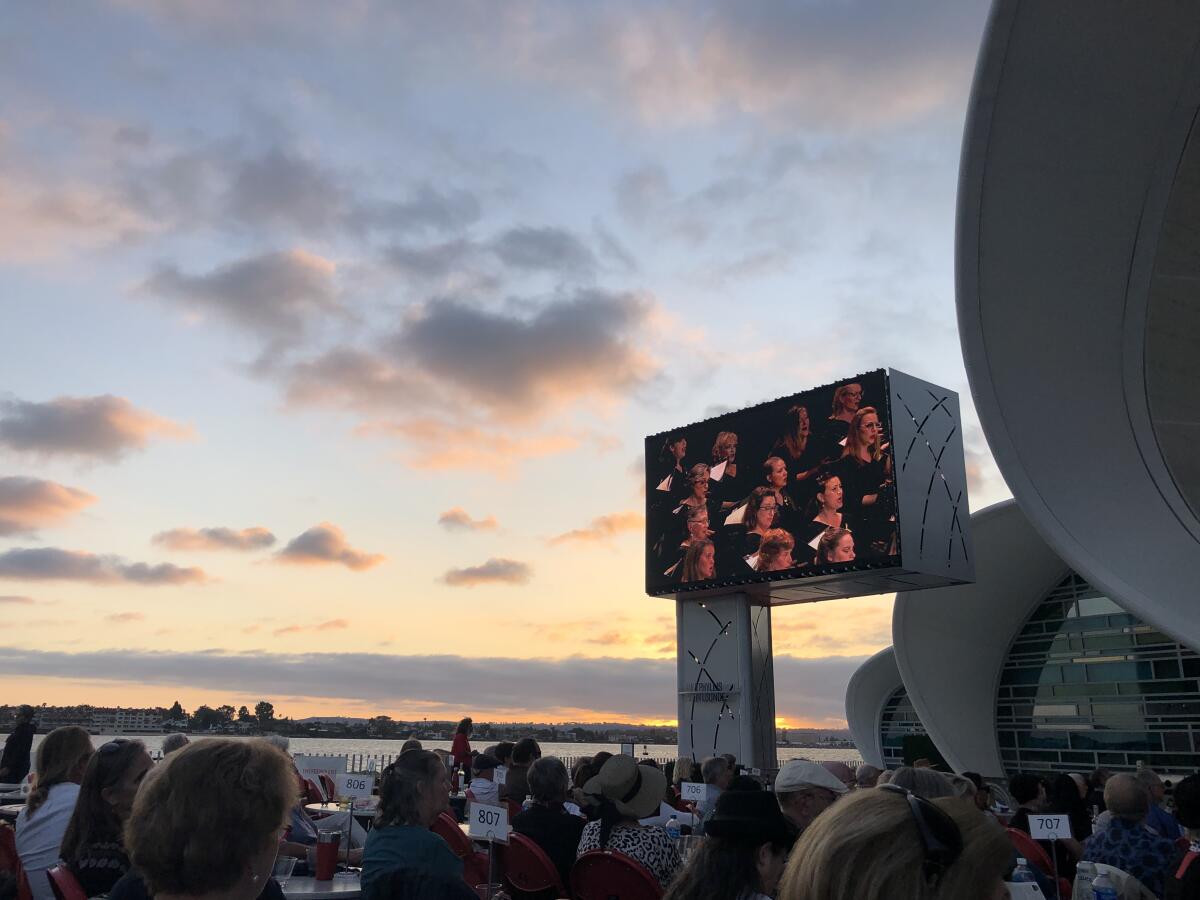
The most dramatic moment came right at sunset — when the sky was James Turrell-shades of blue and orange, the orchestra was illuminated by a glowing light, and Crocetto, in her blue gown, looked like a dazzling water nymph emerging from the bay with her mournful notes.
I’ll definitely be braving traffic on the 5 to see another show at the Rady Shell. Though next time, I’ll have my hat in tow.
Thinking of doing the same? Here’s my guide to San Diego’s new architecture — which includes all the deets on Rady.
On the stage
Times theater critic Charles McNulty was never a fan of “Glee” — “I doubt I ever watched a whole episode,” he writes — nor did he follow the blow-by-blow of the scandal that surrounded Lea Michele, one of the show’s stars, when fellow cast members accused of her bullying and racism in 2020. So when he recently found himself back on Broadway, ready to catch Michele in the title role of “Funny Girl,” he wasn’t exactly thrilled “by the prospect of sitting through this revival again.” Is this one of the rare occasions, however, in which “the right performer in the right role at the right time” have aligned? Well, for the answer you’ll have to read his review.
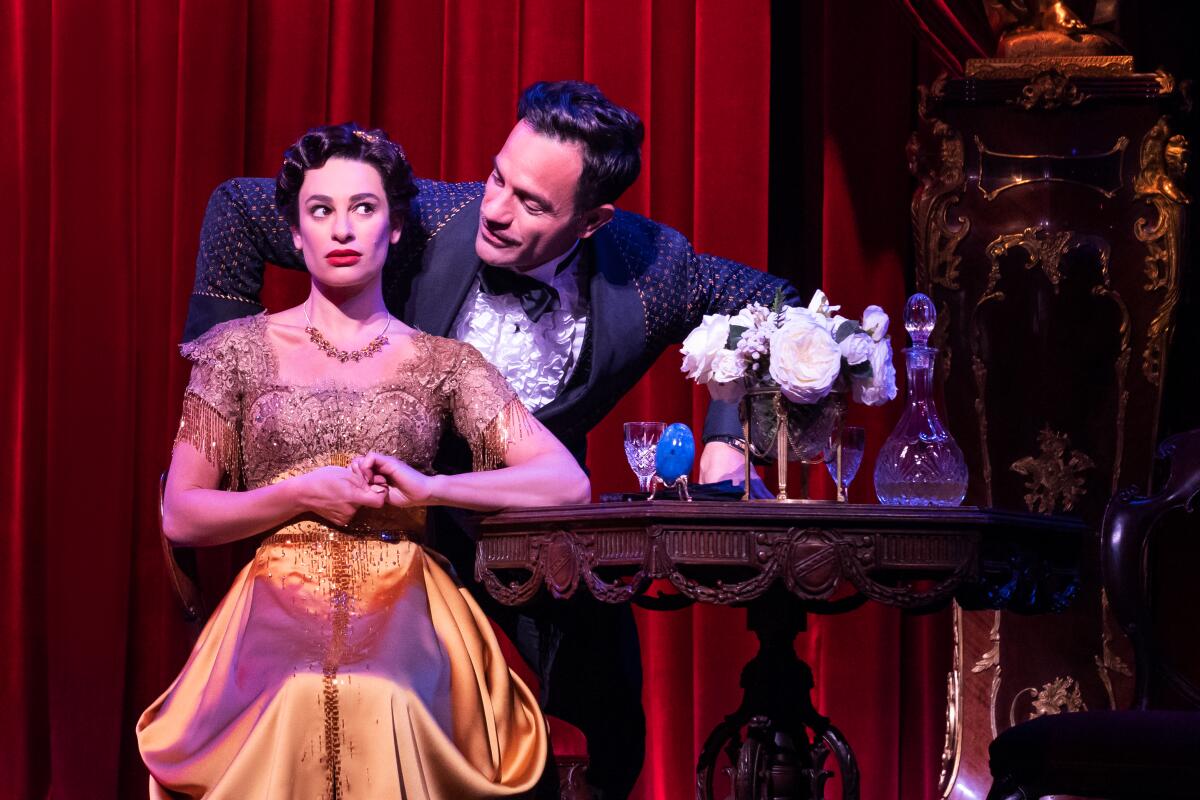
Elsewhere in Broadway news: McNulty also checked out the revival of August Wilson’s “The Piano Lesson,” starring Samuel L. Jackson. The cast, he reports, is top-notch, and “the actors are all fine individually, but their magic fails to coalesce.” Even so, he writes, Wilson’s play has “timely wisdom to impart — the wisdom of unresolved questions.”
“Death of a Salesman” is another compelling revival that recently landed on Broadway, with actor Wendell Pierce in the coveted role of Willy Loman — the first time the roles of Loman and his family have been cast with Black actors. The staging “registers the full seismic shock of this modern American classic,” writes McNulty. “But it takes a while for the tremors to be felt in a staging that sacrifices precision for fluidity.”
The producers of Broadway’s “Hadestown” issued an apology on Thursday to an audience member who was repeatedly reprimanded by a cast member who mistook their captioning device for a recorder.
In and out of the galleries
At the Hammer Museum, art critic Christopher Knight spent some quality time with the “deeply absorbing” work of Kentucky-born painter Bob Thompson. In the show, Knight finds echoes of European paintings by the likes of Lucas Cranach the Elder, Tintoretto and Rembrandt. “Western art history is overrun with themes like bodily violence and spiritual transcendence, and they find resonance in African American life,” writes Knight. “Thompson looks them in the eye.”
My colleague Steven Vargas, in the meantime, took on the Hammer gala. Sightings include Will Ferrell hugging Mark Bradford and Hilton Als hanging with Steven Spielberg. Speeches were speechified. VIPs were honored. Air was kissed. I’m here for all the ways in which photographer Michelle Groskopf wields her flash.
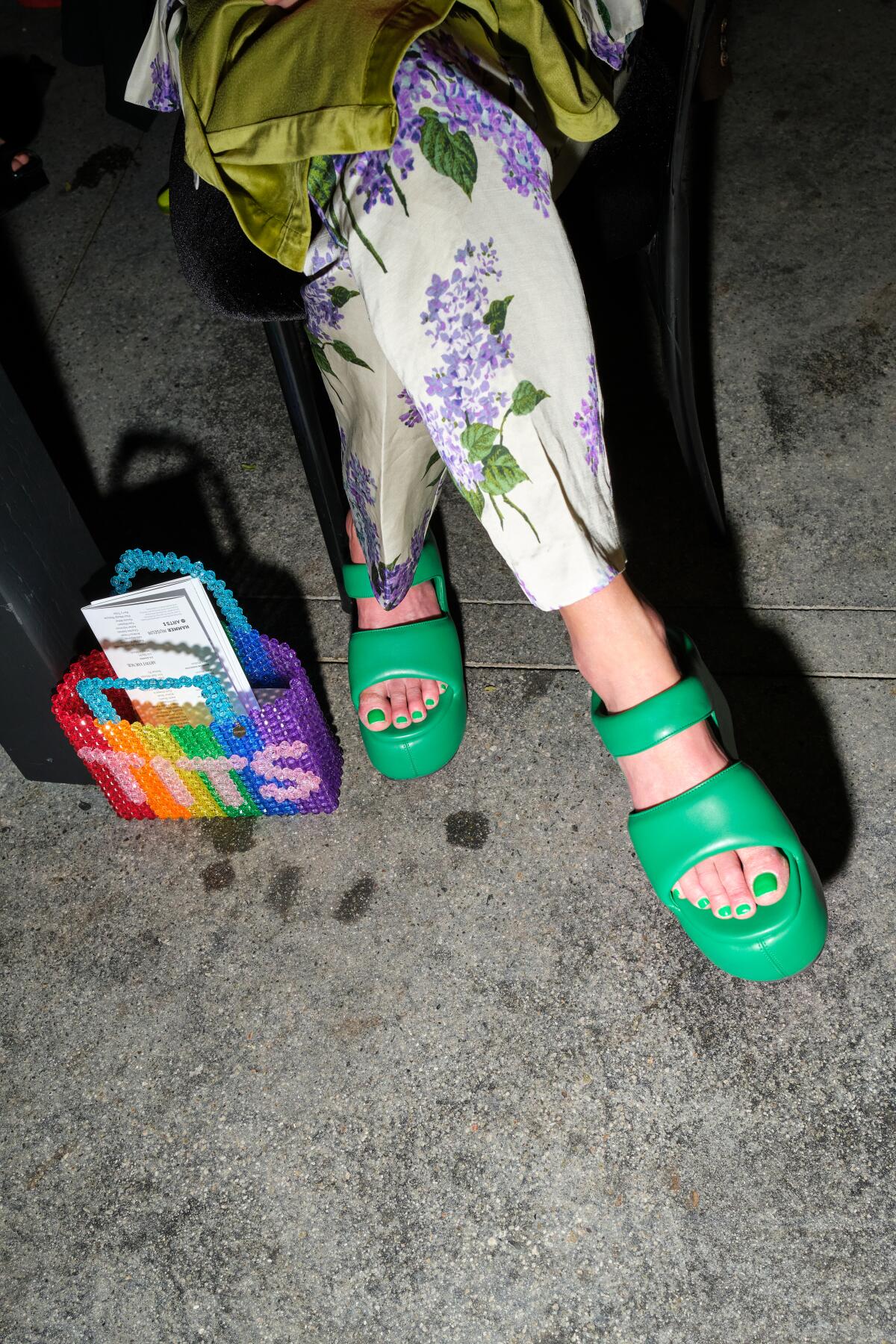
Meanwhile at LACMA ... Times culture writer Deborah Vankin reports that the museum has announced that construction is 50% complete and that their $750-million fundraising campaign for the building currently stands at $700 million. The museum also reports that construction is scheduled to be done by late 2024. Which seems awfully soon? As Vankin notes: “Supply chain issues have made procuring certain construction materials, such as geofoam — a lightweight filling material — and parts such as light fixtures and custom elevator components difficult to procure.”
Earlier this year, I was absolutely bowled over by Sanford Biggers’ quilt pieces in his solo show “Codeswitch” at the California African American Museum. So I was really excited to get to talk to Biggers about that work — as well as his new commission for the Orange County Museum of Art, a large rooftop sculpture that takes European art history and African mask traditions and fuses them in mind-boggling ways. “It’s about the masquerade — the person who wears the mask being able to act their true nature,” he tells me. He may have also told me about that one time he had dinner with Prince.
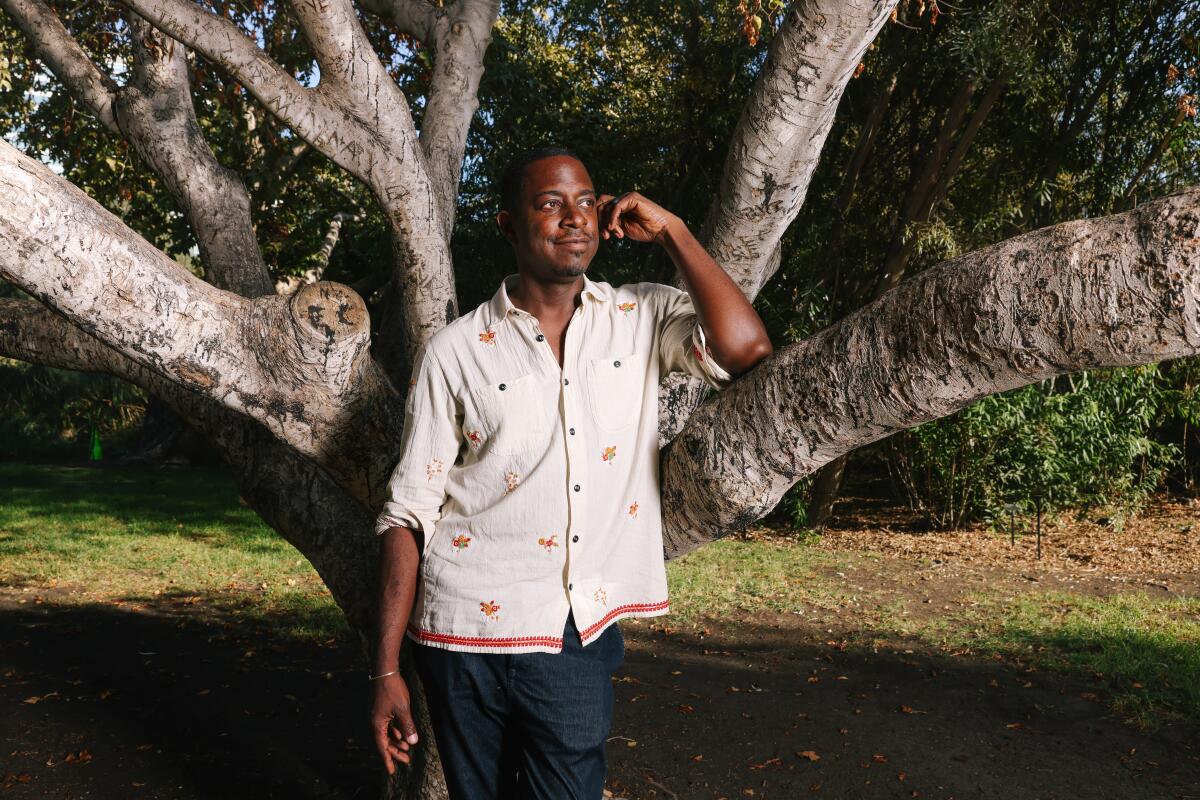
Separately, however, there are troubles at OCMA’s biennial show, “Pacific Gold.”
In a story in Los Angeles magazine, Michael Slenske reports that L.A.-based artist Ben Sakoguchi says that his 16-panel work “Comparative Religions 101,” originally touted as a highlight of the biennial, was later rejected from the show because it contained a swastika. “The use of the swastika in this context is merely historical and employed as a device to align the atrocities of Japan during the war with those of Nazi Germany,” writes Slenske of the work in question. “Clearly, the curators did not find this offensive, anti-Semitic, or even in bad taste. They would surely know the historical origins of the swastika, which originated in Eurasia some 7,000 years ago and was used in ancient religions for centuries before the Nazis and Hitler co-opted it as a hate symbol.”
Hyperallergic’s Matt Stromberg writes that Sakoguchi has claimed that the museum has a policy against showing swastikas. But he found at least one occasion — in a Peter Saul retrospective in 2008 — in which swastikas had been shown in a work at the museum. In an email to Hyperallergic, curator Essence Harden stated: “I wanted to affirm that the curatorial team for the biennial and the institution are two separate entities; the curatorial team is not staff but rather contractors for the exhibition. Ultimately, the institution had the final deciding power on what would be exhibited for Pacific Gold.”
For the record:
11:51 a.m. Oct. 15, 2022An earlier version of this newsletter stated that a spokesperson for the Orange County Museum of Art said the museum had a policy against showing swastikas. It was a claim made online by painter Ben Sakoguchi.
Enjoying this newsletter? Consider subscribing to the Los Angeles Times
Your support helps us deliver the news that matters most. Become a subscriber.
A pair of protesters from Just Stop Oil bathed a Van Gogh painting at London’s National Gallery with a can of tomato soup on Friday. Vankin spoke with independent paintings conservator Chris Stavroudis to get a sense of how much damage a can or two of soup might do to an oil painting. The material (tomato) is a concern because it’s highly acidic. But thankfully the protesters chose a painting that was covered in glass.
In a dispatch from Washington, D.C., The Times’ David G. Savage reports on a critical intellectual property case before the U.S. Supreme Court. It involves the use of an image of Prince, taken by photographer Lynn Goldsmith, that was later employed by Andy Warhol for a canvas. At the heart of the case is the issue of how far artists may go in incorporating the work of others in their own pieces.
In the Atlantic, writer Paul Szynol says that if the court rules in favor of Goldsmith, it could strangle fair-use protections.
Classical notes
Mirga Gražinyte-Tyla recently led the City of Birmingham Symphony Orchestra in a pair of shows at the Segerstrom Center for the Arts in Costa Mesa and Disney Hall in Los Angeles. Times classical music critic Mark Swed describes a musical director who displays “a pressing preoccupation with the texture and power of sound. That could be an exceptional solo clarinet exposing a moment of personal rapture, a heavenly string section filling a concert hall with the cathedral-like awe of communal spirituality. It could also be brass and percussion simply blowing you away.”

Scandal council
In case you’re wondering what that giant sucking sound was, it was the L.A. City Council blowing itself up after an audio was leaked in which several Latino council members could be heard making (or passively listening to) disparaging, homophobic and sexist remarks about fellow council members, Black people and Indigenous people. I have a look at how the racist remarks enter a roiling debate about the nature of Latino identity — a.k.a. Latinidad — and the blinkered ways in which that identity has been defined and wielded.
Earlier this week, as the council imploded, my editor, Boris Kachka, who was born in the former Soviet Union (Moldova, represent!), mentioned to me that when there were leadership crises in the U.S.S.R., state television would play Tchaikovsky’s “Swan Lake.” Apparently, “Swan Lake” has also emerged as a theme in subversive Russian protests against the invasion of Ukraine.
This led me to ask Twitter what we should play on TV here in Los Angeles during our crisis of leadership. My favorite responses: “The Big Lebowski,” suggested by @benlazeb; George Michael’s “Careless Whisper,” courtesy of @sahrasulaiman; Tom Petty’s “Free Fallin’,” from @MichaelG398; and high-speed car chases, from @LawrenceCPhD and @HeartAsArena. Thank you, Twitter, for continuing to deliver.
The magic hour
Deborah Vankin takes a breather from the fine arts racket to hang with the magician set. She spent time with a crew of young tricksters at a “magic jam,” informal gatherings where performers can connect with fellow magicians and hone their craft. “Often magicians will work through a challenging trick at a magic jam,” she writes, “or get feedback on a line of dialogue for a show.”
Plus, she also comes through with a guide on where to catch the magic in L.A.
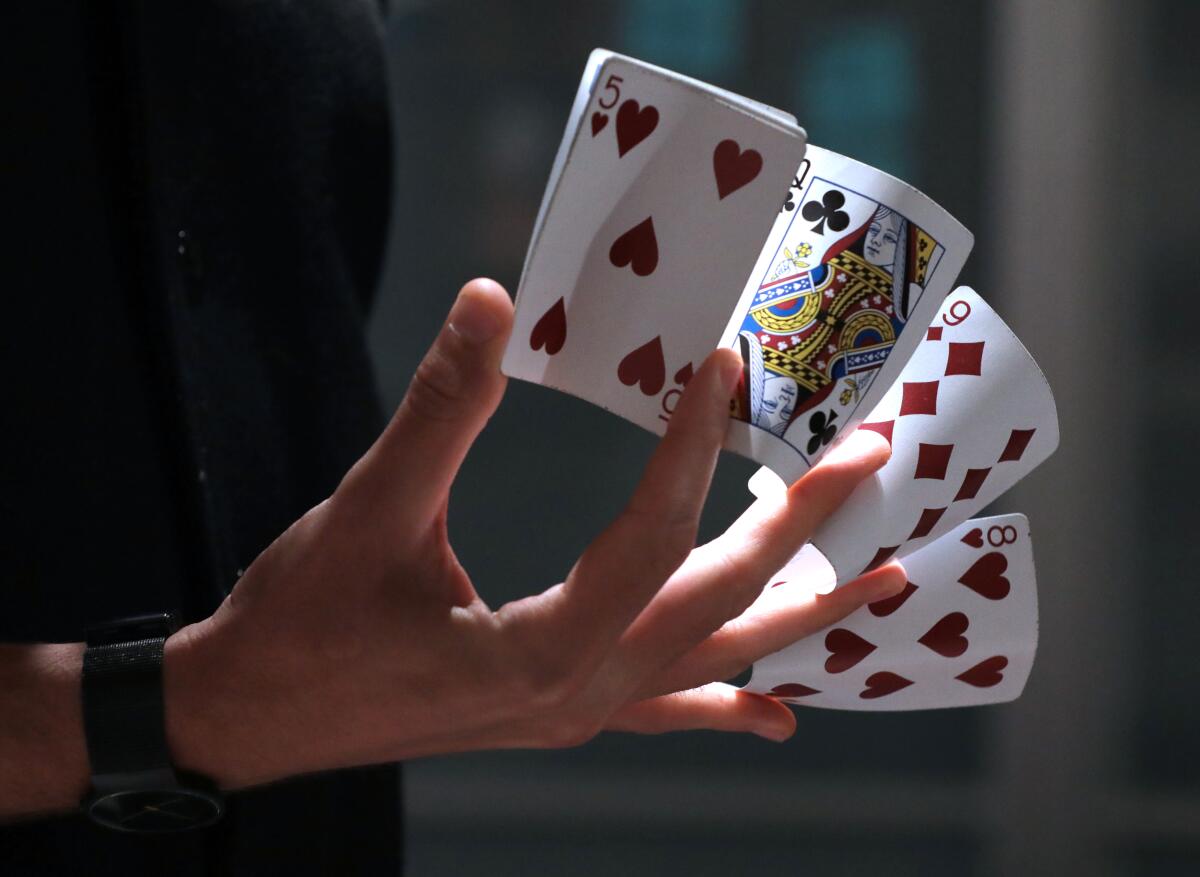
Moves
The season premiere of PBS’ “Craft in America” will feature an interview with three generations of Saars: Betye Saar, Alison Saar and Maddy Leeser.
The MacArthur Foundation has announced its class of 2022 “genius” grant winners. Among the recipients are musician and scholar Martha Gonzalez of Scripps College, as well as artists Sky Hopinka, Paul Chan and Tavares Strachan; composers Ikue Mori and Tomeka Reid and architect Amanda Williams.
Passages
Angela Lansbury, the Tony-winning star of screen and stage, known for murder mysteries but also for her turn as the zestful “Mame” on Broadway, has died at 96. Charles McNulty writes an appreciation for a performer who functioned like “a royal in exile, astringently self-possessed, her syllables arrayed like fine china, she was at once instantly recognizable and readily transformable.”
Billy Al Bengston, a Los Angeles painter who helped establish L.A.’s Cool School at the Ferus Gallery, known for works that riffed on custom car culture and pop, has died at 88. In an obituary, The Times’ Jessica Gelt describes “a rebellious youth, known for mixing good fun with a bad-boy persona.”
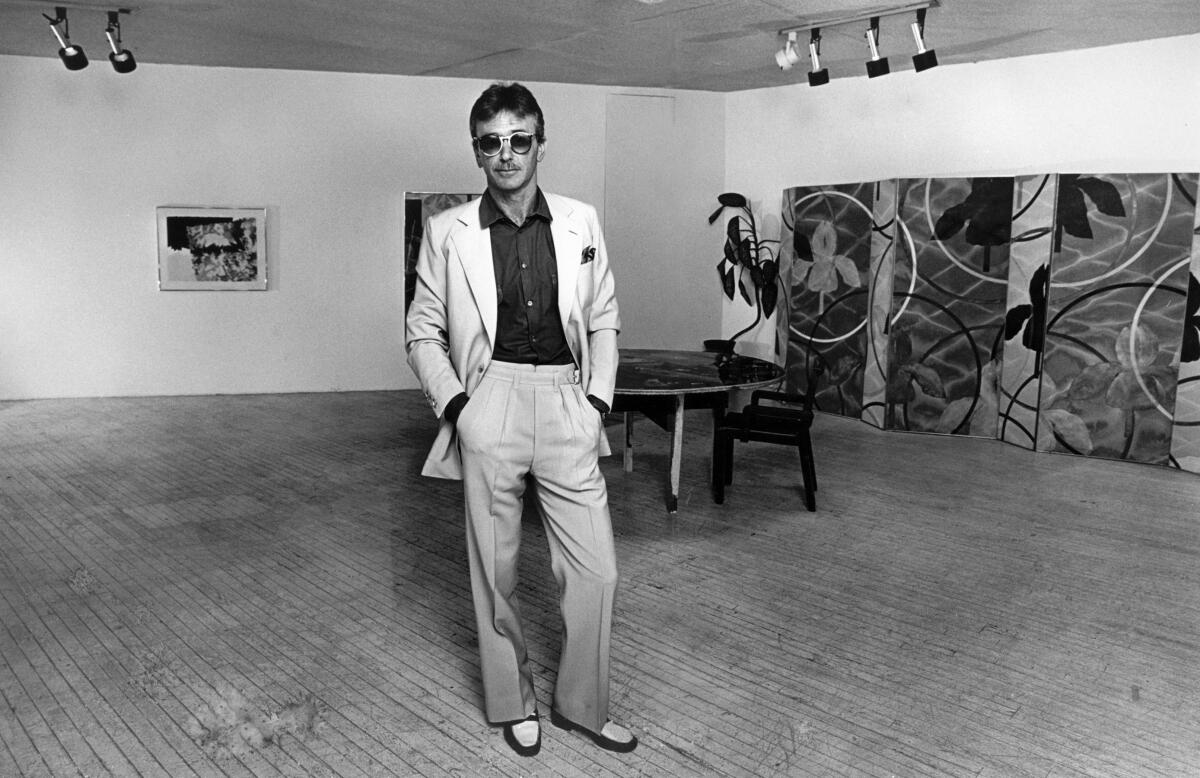
Silke Otto-Knapp, a painter known for her enigmatic landscapes composed of deeply layered watercolors, has died at the age of 52. “Poetic landscapes and seascapes formed another prominent body of work,” writes Christopher Knight in an obit, “sometimes evoking unsettled paintings by Norwegian Expressionist Edvard Munch, visionary landscapes by British Romantic artist Samuel Palmer or floating clouds by American artist Georgia O’Keeffe.”
In other news
— After nearly 200 years, the Tongva community finally has land to call its own in L.A. County.
— A big Keith Haring show is set to land at the Broad museum in May.
— Pasadena’s role in harboring a 20th century avant-garde.
— New York’s Avery Fisher Hall — now David Geffen Hall — is showing off its revamped home for the New York Philharmonic, courtesy of Gary McCluskie of Diamond Schmitt Architects and acoustician Paul Scarbrough. The New York Times’ Zachary Woolfe kicks the tires on a building that was never renowned for its sound.
— Meanwhile, New York Times architecture critic Michael Kimmelman has a look at the hall’s architectural redo from a design perspective. “Geffen is a vast improvement over Fisher,” he writes, “which, in its decline, had come to possess the charm and intimacy of Terminal 2 at Kennedy.”
— New York’s Metropolitan Opera has just announced a new on-demand streaming service. “Fire Shut Up in My Bones,” here I come.
— Washington, D.C.’s National Gallery confirms that that one of its Vermeers is not a Vermeer.
— A wildfire on Easter Island has done “irreparable” damage to moai statues.
— An anonymous artist dyed Tehran fountains blood red during recent protests over the death of Mahsa Amini.
And last but not least ...
With only the utmost respect: Angela Lansbury as teapots.
The biggest entertainment stories
Get our big stories about Hollywood, film, television, music, arts, culture and more right in your inbox as soon as they publish.
You may occasionally receive promotional content from the Los Angeles Times.




